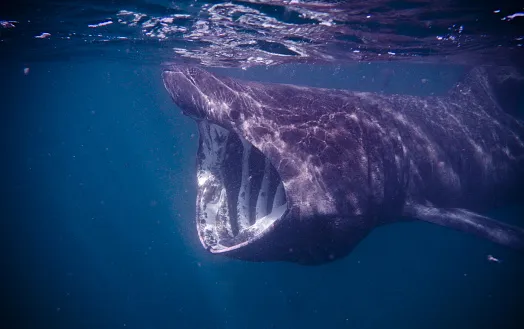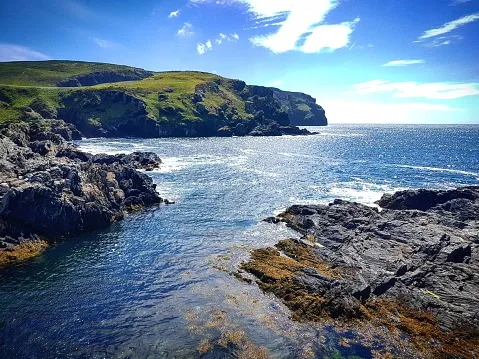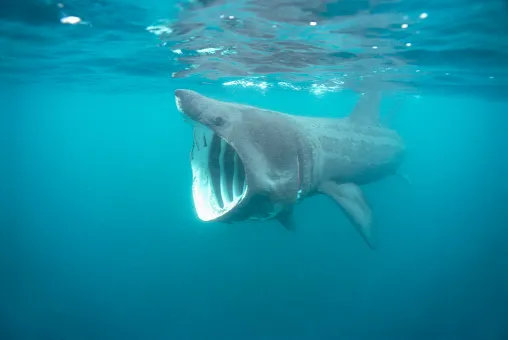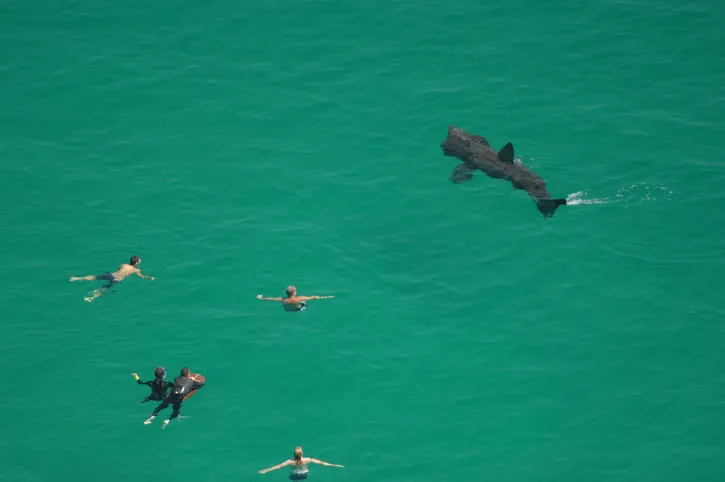We should have great white sharks around Britain. The water temperature is right and the UK is a stronghold for seals. But we don’t. The nearest verified great white sighting was 200km away, off the Brittany coast.
It doesn’t stop us hoping though. Every summer, headlines scream of “bloodthirsty killers” or calmer warnings of “occasional vagrant visits” around our beaches, following sightings of large dorsal fins. Still, at least it lets us tout an amazing statistic: that we’re more likely to be killed by a vending machine than a shark. Just as amazing, and a whole lot more depressing, is that according to a 2013 survey, it’s estimated that humans kill between 63 million and 273 million sharks per year, whereas sharks kill fewer than seven people. So there’s no need to worry if you’re swimming in British seas – unless perhaps you’re a shark.
But despite our lack of great whites there are dorsal fins to spot. If you’re on the west coast it’s likely that the one-metre dorsal fin causing panic on the shore belongs to the second-largest fish in the ocean: the basking shark. The way to tell is how it swims through the water. If the fin moves in a zigzag motion, then it’s a basking shark.

Considering their size (up to 8m), basking sharks have an underwhelming diet: plankton. We have ideal feeding grounds for them. During the winter months, storms bring nutrients from deep waters to the surface where photosynthesis can occur, producing microscopic plant life that becomes food for microscopic animal life.

From May to October basking sharks migrate up Britain’s west coast to feed. But where were they before that? And where do they go at the end of the summer? These are questions scientists are still trying to answer.
A long day of not filming
On the summer solstice of 2007 I was on the Isle of Man with a film crew trying to make a basking shark story. As with all underwater stories, it’s almost impossible to know where to point your boat when what you want is hidden beneath the surface. But this is TV, so we had one day to get what we needed.

By 6pm we were bobbing around with hours of tape left and had exhausted every favour our skipper could call in from nearby wildlife-watching trips. But our cameraman had another assignment the following day in London so he had to depart by boarding another boat and disappearing east, leaving us with no basking sharks, no story and no cameraman. Not the checklist our director had hoped for. But we couldn’t come back with nothing – budgets (and pride) simply don’t allow it. All was not lost, however; we still had a small camera for filming underwater, which would do for shooting topside. As it was the solstice, we had at least another fours hours of light.
A late appearance
Of course, as soon as our main cameraman had gone, a basking shark appeared on our starboard quarter. But I couldn’t jump in front of the camera straight away. We’d piggybacked on a research vessel lead by Dr Mauvis Gore, who first had to attach a £2,000 tag on to the basking shark before we could start getting the footage we needed. So we decided to prepare ourselves by filming her attempts to tag the shark.

Dr Gore has exactly what we love in a contributor: the ability to emote while being authentic. We held our breath while the boat was slowly manoeuvred and Dr Gore planted the tag precisely on the basking shark’s back. As soon as the tag was attached she threw her arms in the air, swung round to face us all and whooped with sheer glee – immediately making her one of my favourite contributors.

I loved that day: the solstice, a crew up against it, a superb contributor and, best of all, being in the water. Treading water 15m from the boat, I waited, hoping our basking shark would swim past again. After 10 minutes, a two-metre dorsal fin began slowly making its way closer. My heart still leaps at the memory of holding my breath, half scared, half awed as the colossal mouth glided towards me then slipped slowly past, hoovering up plankton as it went.

